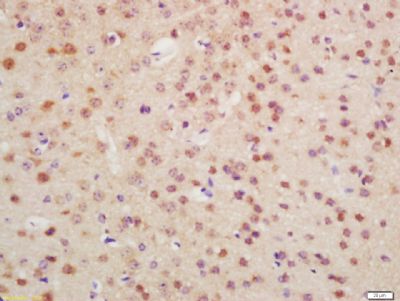
OTX1 + OTX2,转录因子OTX1+OTX2抗体
产品名称: OTX1 + OTX2,转录因子OTX1+OTX2抗体
英文名称: Anti-OTX1 + OTX2 antibody
产品编号: HZ-11958R
产品价格: null
产品产地: 中国/美国
品牌商标: HZbscience
更新时间: 2023-08-17T10:24:20
使用范围: WB,ELISA,IHC-P,IHC-F,IF
- 联系人 : 鲍丽雯
- 地址 : 上海市闵行区闵北路88弄1-30号第22幢AQ136室
- 邮编 : 200612
- 所在区域 : 上海
- 电话 : 139****0749 点击查看
- 传真 : 点击查看
- 邮箱 : www.shzbio.net
- 二维码 : 点击查看
OTX1 + OTX2,转录因子OTX1+OTX2抗体
产品编号HZ-11958R
英文名称OTX1 + OTX2
中文名称转录因子OTX1+OTX2抗体
别 名FLJ38361; Homeobox protein OTX 1; Homeobox protein OTX1; Homeobox protein OTX2; MCOPS 5; MCOPS5; MGC15736; MGC45000; Orthodenticle 1; Orthodenticle 2; Orthodenticle homeobox 1; Orthodenticle homeobox 2; Orthodenticle homolog 1; Orthodenticle homolog 2 (Drosophila); Orthodenticle homolog 2; Orthodenticle1; Orthodenticle2; Otx 1; Otx 2; otx1; OTX1_HUMAN; otx2; OTX2_HUMAN.
说 明 书0.1ml 0.2ml
研究领域细胞生物 发育生物学 神经生物学 干细胞 表观遗传学
抗体来源Rabbit
克隆类型Polyclonal
交叉反应 Human, Mouse, Rat, Chicken, Dog, Pig, Cow, Horse, Rabbit, Sheep,
OTX1 + OTX2,转录因子OTX1+OTX2抗体产品应用WB=1:100-500 ELISA=1:500-1000 IHC-P=1:100-500 IHC-F=1:100-500 ICC=1:100-500 IF=1:100-500 (石蜡切片需做抗原修复)
not yet tested in other applications.
optimal dilutions/concentrations should be determined by the end user.
分 子 量37/32kDa
细胞定位细胞核
性 状Lyophilized or Liquid
浓 度1mg/1ml
免 疫 原KLH conjugated synthetic peptide derived from human OTX1 + OTX2
亚 型IgG
纯化方法affinity purified by Protein A
储 存 液0.01M TBS(pH7.4) with 1% BSA, 0.03% Proclin300 and 50% Glycerol.
保存条件Store at -20 °C for one year. Avoid repeated freeze/thaw cycles. The lyophilized antibody is stable at room temperature for at least one month and for greater than a year when kept at -20°C. When reconstituted in sterile pH 7.4 0.01M PBS or diluent of antibody the antibody is stable for at least two weeks at 2-4 °C.
OTX1 + OTX2,转录因子OTX1+OTX2抗体PubMedPubMed
产品介绍background:
Transcription factors, OTX1 and OTX2, are two murine homologs of the Drosophila orthodenticle (OTD), show a limited amino acid sequence divergence. OTX1 and OTX2 play an important role during early and later events required for proper brain development in that they are involved in the processes of induction, specification and regionalization of the brain. OTX1 is involved in corticogenesis, sensory organ development and pituitary functions, while OTX2 is necessary earlier in development, for the correct anterior neural plate specification and organization of the primitive streak. OTX2 is also required in the early specification of the neuroectoderm, which is destined to become the fore-midbrain, and both OTX1 and OTX2 co-operate in patterning the developing brain through a dosage-dependent mechanism. A molecular mechanism depending on a precise threshold of OTX proteins is necessary for the correct positioning of the isthmic region and for anterior brain patterning. The genes which encode OTX1 and OTX2 map to human chromosomes 2p13 and 14q21-q22, respectively.
Function:
Function: Probably plays a role in the development of the brain and the sense organs. Can bind to the BCD target sequence (BTS): 5'-TCTAATCCC-3'.
Subcellular Location:
Nucleus
Tissue Specificity:
Expressed in brain.
DISEASE:
Defects in OTX2 are the cause of microphthalmia syndromic type 5 (MCOPS5) [MIM:610125]. Microphthalmia is a clinically heterogeneous disorder of eye formation, ranging from small size of a single eye to complete bilateral absence of ocular tissues. Up to 80% of cases of microphthalia occur in association with syndromes that include non-ocular abnormalities. MCOPS5 patients manifest unilateral or bilateral microphthalmia/clinical anophthalmia and variable additional features including coloboma, microcornea, cataract, retinal dystrophy, hypoplasia or agenesis of the optic nerve, agenesis of the corpus callosum, developmental delay, joint laxity, hypotonia, and seizures.
OTX1 + OTX2,转录因子OTX1+OTX2抗体Similarity:
Belongs to the paired homeobox family. Bicoid subfamily. Contains 1 homeobox DNA-binding domain.
Gene ID:
5013
Database links:
Entrez Gene: 5013 Human
Entrez Gene: 5015 Human
Entrez Gene: 18423 Mouse
Entrez Gene: 30501 Zebrafish
SwissProt: P32242 Human
SwissProt: P32243 Human
SwissProt: P80205 Mouse
SwissProt: P80206 Mouse
SwissProt: Q91981 Zebrafish
Unigene: 288655 Human
Unigene: 445340 Human
Unigene: 129663 Mouse
Unigene: 134516 Mouse
Unigene: 334 Zebrafish
Important Note:
This product as supplied is intended for research use only, not for use in human, therapeutic or diagnostic applications.

